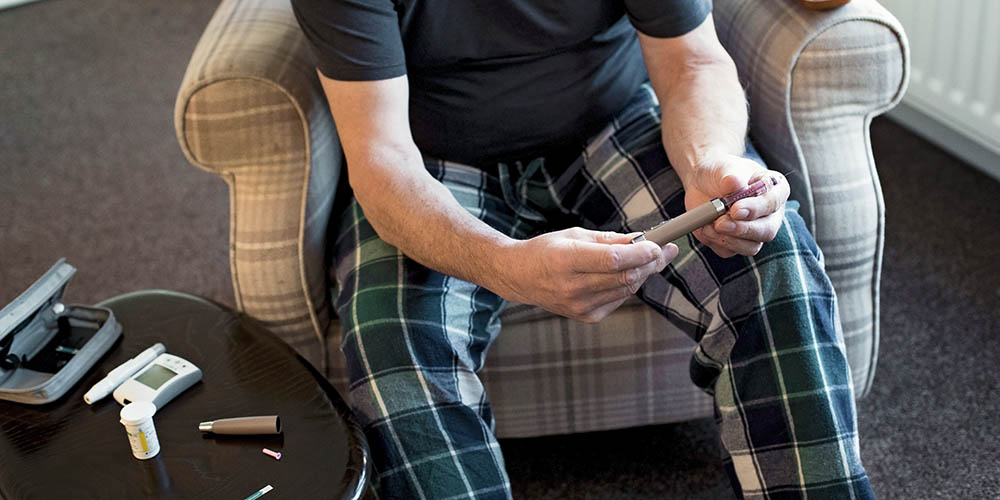
Reading Time: 5 minutes
This case is important to highlight for the following reasons:
- Many people with diabetes – and healthcare professionals – tend to focus solely on fasting blood sugar values, but you can have excellent fasting blood sugars and still have an inadequate A1c.
- Post-meal glucose values contribute significantly to A1c.
- Many people with diabetes don’t realize that high blood sugar in the morning is a natural result of counterregulatory hormones at work.
Meet the Patient: Ruben
Ruben is a 57-year-old male who has had type 2 diabetes for seven years.
He currently takes 1000 mg of metformin twice per day, and 45 units of basal insulin (long-acting insulin) Toujeo once a day. Several months ago he also started taking Ozempic, and he’s titrated up to the max dose of 2 mg once a week.
His fasting blood sugars are really good – generally between 95-130 mg/dL – but his A1c still hovers in the low 8% range. The goal for Ruben is definitely below or close to 7% to prevent complications over time.
The Problem: High Blood Sugar in the Morning after Eating
Ruben is doing everything he can to manage his diabetes, but he still struggles with post-meal blood sugar spikes, especially after breakfast. He does watch what he eats but he looooooves a good breakfast – it’s his absolute favorite meal of the day.
Most mornings he has egg beaters with a side of hashbrowns (with hot sauce on top) and an English muffin with low-sugar jelly. Not too bad, but his blood sugar two hours after the meal is almost always over 200 mg/dL – and often over 250 mg/dL.
For lunch he typically eats a turkey sandwich using thinly sliced Dave’s Killer Bread (60 calories a slice) with a small bag of chips. Dinner is typically a chicken and rice bowl, a 5 Guys burger with his buddies, or grilled steak and potatoes. For the most part his 1-2 hour post-meal lunch and dinner numbers stay closer to 150-200 mg/dL.
So the big question is, why do his blood sugars spike so much higher after breakfast?
The Morning Counterregulatory Hormone Affect
Ruben’s situation is actually very common.
In the morning, the body releases “wake up” hormones called counterregulatory hormones (glucagon, epinephrine/adrenaline, growth hormone, and cortisol) that lead to insulin resistance. For the average person without diabetes, their pancreas simply secretes more insulin to overcome these issues.
For people with diabetes who don’t make enough insulin or their insulin doesn’t work well, this can lead to a bigger spike in blood sugar after eating in the morning.
This is different from the Dawn Phenomenon or Foot-to-Floor syndrome. With Dawn Phenomenon, your blood sugar starts to creep up around 3:00 am because of the diurnal secretion of the counterregulatory hormones. Foot to Floor syndrome happens when your counterregulatory hormones go up simply from getting out of bed.
There’s no fancy syndrome name for what Ruben has when blood sugar spikes higher than normal after breakfast, but it happens all the time.
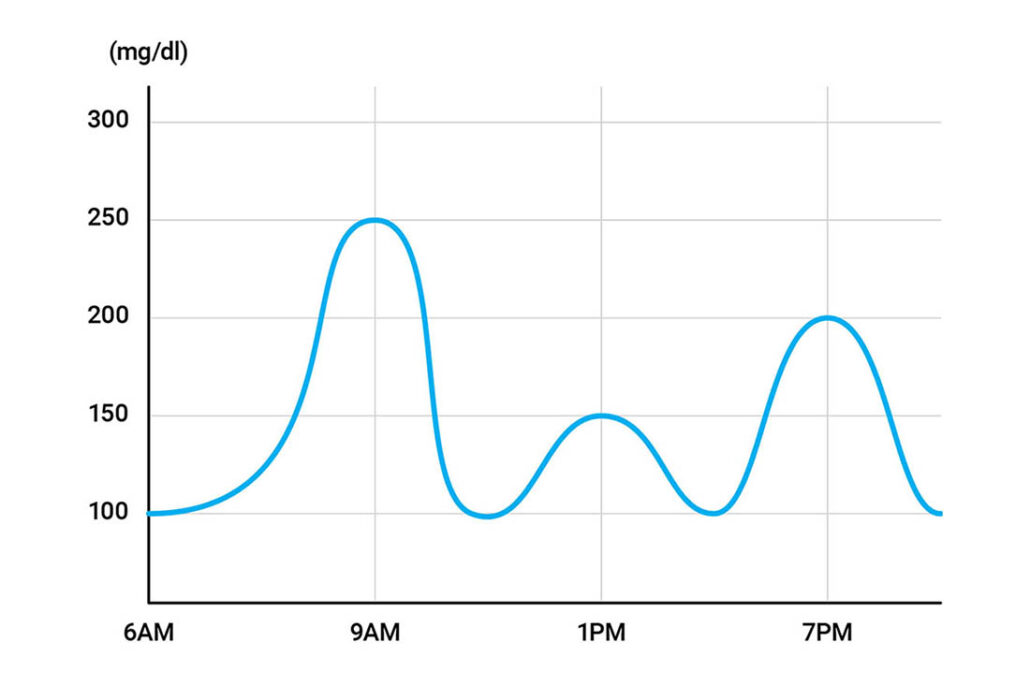
On top of that, many breakfast foods like toast, jam, pancakes, cold cereals like TRIX (my favorite), juice, etc. are simple carbs, which can cause blood sugar to rise even faster. Together, these factors make blood sugars after breakfast harder to control compared to other meals later in the day.
The Solution
Ruben really just needs to work on fixing his morning blood sugar spikes. His primary care doctor recommended short-acting mealtime insulin, but Ruben didn’t want to start it because he was worried about gaining weight, and one shot a day was enough for him. His doctor suggested inhaled insulin Afrezza, which Ruben was willing to try.
What Is Afrezza?
Afrezza is a rapid-acting inhaled human insulin you breathe in through your lungs through a small inhaling device.
The insulin kicks in really fast, (in about 12 minutes) hits its peak in about 45 minutes, and then is out of your system within 1.5 to 3 hours.

What Are the Benefits of Afrezza?
If you’re on subcutaneous insulin for meals, you have to remember to take it 20-30 minutes before you start eating to fight post-meal elevated glucose levels, and that is really hard to remember to do.
You can take Arezza inhaled insulin when you start your meal because it gets into your system fast, so it’s convenient and easy to remember for many people. Also, since it leaves your system quickly you have less hypoglycemia in the few hours after a meal. There’s also less weight gain than with injected insulin.
Inhaled Insulin Benefits:
- You take it at the start of a meal
- It gets into your system fast and out of your system fast
- Less risk of hypoglycemia
- Less weight gain
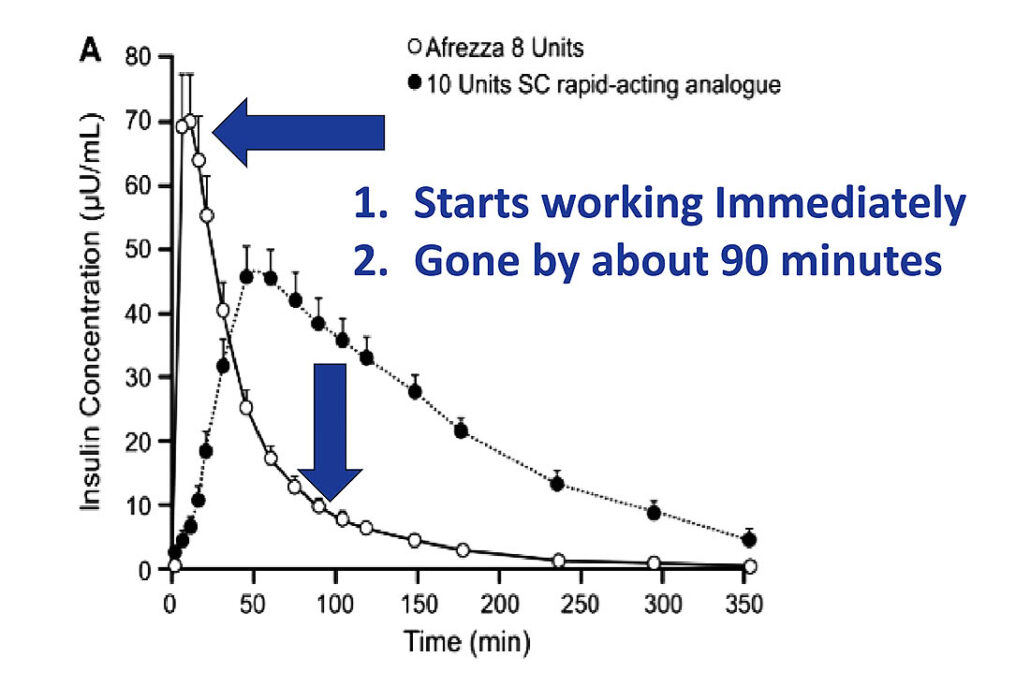
How to Take Afrezza
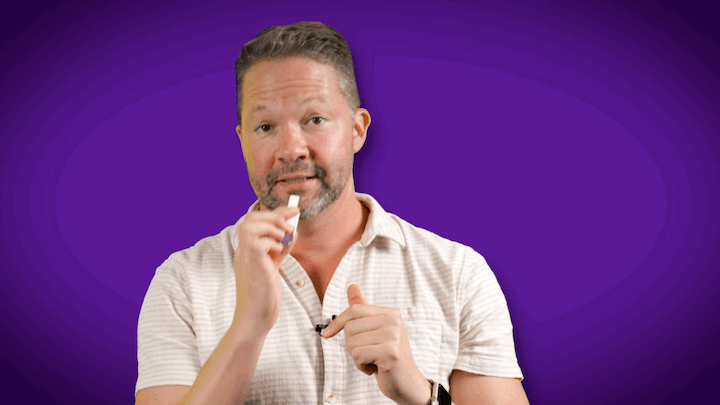
Afrezza comes in color-coded single-dose cartridges containing either 4 units (blue), 8 units (green), or 12 units (yellow) of inhaled insulin. Units of inhaled insulin are not the same as units of injectable insulin. The 4-unit cartridge of Afrezza is similar to 2 units of subcutaneous insulin, 8 units of Afrezza is like 4 units of subcutaneous insulin, and 12 units of Afrezza is like 6 units of subcutaneous insulin.
This video has step-by-step instructions on how to use Afrezza inhaled insulin:
Does Afrezza Have Side Effects?
The most common side effect of inhaled insulin is a dry cough when you inhale it (especially if it’s cold and you inhale too quickly). Proper technique is easy but important, and taking Afrezza when it’s at room temperature will help reduce coughing.
You can keep any Afrezza you’re not using in the fridge. The packages you’re planning on using in the next week or two don’t have to be refrigerated. The cough (if you experience it) typically will subside over time. Since Afrezza is insulin, it can cause hypoglycemia.
Can Anyone Use Afrezza?
As with most medications, there are some people who should not use Afrezza, including anyone with long-term, chronic lung problems such as asthma or COPD. Afrezza is also not recommended for people who smoke or who have stopped smoking in the last six months.
Your doctor should order a simple baseline test called the FEV1 or incentive spirometry to check your lung function before you start Afrezza, six months in, and yearly after that.
The Plan for Ruben
Ruben started on 12 units of Afrezza inhaled insulin with his breakfast, and then titrated up to 20 units (he takes a 12 and 8 unit cartridge back-to-back) to get his after-breakfast blood sugars down to the 150 mg/dL range. After a few months, his A1c came down to 7.1%.
He didn’t gain any weight or experience any hypoglycemia, and he really liked not having to administer another insulin shot.
Additional Recommendations
Before Ruben started on basal insulin he wasn’t eligible for a CGM through insurance. Personally, I would recommend that he get a CGM now. It makes starting Afrezza so much easier when you can see your glucose response after meals. It will also be helpful for him to see how other factors like exercise and food affect his glucose.
The Takeaway
If you’re struggling with high blood sugar in the morning – especially after breakfast – it’s not a personal failing. It’s biology. The main learning point is that if you ate the same thing for breakfast, lunch, and dinner, your blood sugars would be highest after breakfast because the natural release of counterregulatory hormones in the morning simply makes it harder to manage blood sugar.
But as Ruben’s case shows, there are effective tools and strategies that can help. Fast-acting options like Afrezza can significantly smooth out post-breakfast spikes without adding the burden of extra injections or increasing the risk of weight gain.
Afrezza is a much better solution in this situation than subcutaneous insulin because Afrezza doesn’t hang around in your system for three, four, or five hours, and you’ll have a much lower rate of delayed hypoglycemia.
Taking a “hit” in many states is a common thing now, without the risk of being arrested!
For more information on Afrezza and other ways to take control of your diabetes, visit our resource library and video vault.
Additional Resources:

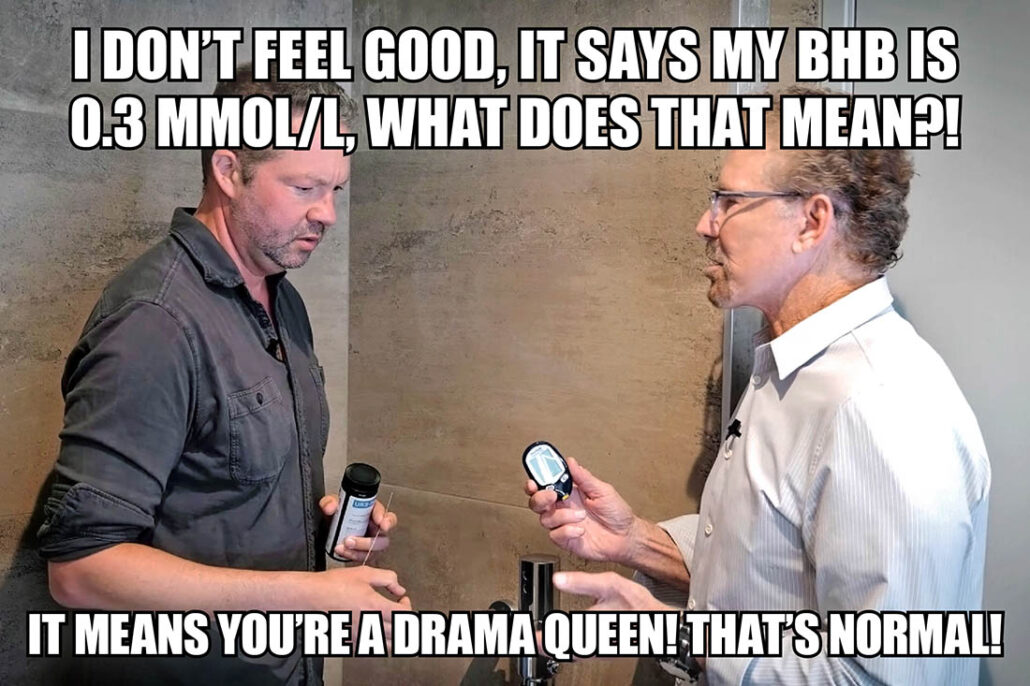
Hello
I am an 85 year old female who was diagnosed with type 1 brittle diabetes at 75. Initially diagnosed with type 2. I am presently using the Libre 3 CGM and inPen.
My endo feels, at my age, an insulin pump may be too complcated for me. Your thoughts please. Thank you.
Hi …
I’m a 81 yr old female, diabetic for 27 yrs, and on a pump for the past 24 yr, and do quite well…….70% TIR, 7.2 A1 c. True, the technology of pumps is very complicated and can be very stressful, and if one has any memory lapses,etc, it could be extra challenging, as your dr stated. But, if you’re still quite sharp, with extreme dedication, you probably could do it . But, today’s pens,etc are awesome, I hear.
La Quinta, Ca
I have many patients in their 70s and 80s who do extremely well on pumps that communicate with a CGM, also called HCL systems. It makes their life so much better, safer, and helps them to have a better A1c. Take a look at this video and article to learn a little more about the systems that are available and see which one you might be interested in:
https://tcoyd.org/automated-insulin-delivery-systems-comparison/
https://tcoyd.org/2025/04/automated-insulin-delivery-systems-comparison/
I am a 70 yr old t2 diabetic for 15years. My latest A1C was 8.8. My main problem is once I have a moderate amount of pasta or half a bagel my blood sugar spikes can last 3-4 hours. I am currently on 25mg Jardiance, 2000mg metforman, 2mg Repaglinide with each meal and 6mg of glymiperide daily in the AM. I recently started using a Dexcom CGM and am trying various supplements like berberine, gynemma, Apple cider vinegar capsules. Post meals peak at 200-280 and last 3-4 hrs. I am learning to include more protein, fat and fiber in my diet to slow the blood sugar rise. Controlling my diabetes has been difficult because I have been insulent resistant most of my life. It seems Affrezza might be a good fit for me. Does Medicare cover this insulin for T2 diabetics?
With an A1c of 8.8%, that’s pretty high. Nothing against supplements, but they’re not helping you. It really looks like you’re going to need some insulin with meals, and I would not be afraid of that. It will liberate your diet, and you’ll find the right dose that will keep you from bouncing up above 200 mg/dL, and you’ll be able to enjoy the foods you like to eat. Afrezza is covered by Medicare, but you should confirm coverage with your health plan. Afrezza does have a program for $99/month for cash payers. I would think that you’re going to need subcutaneous fast-acting insulin taken 15-20 minutes before you eat, and Afrezza on top of that at certain times.
I have been on insulin for 52 years. I want to be in control of my body. I am on a 770 pump for a long time . I kept me alive. Saved my life one night when I was in bed . I is a in when it wake me up to alert me to low blood sugar. I now have a great night of sleep when I eat a KIWI fruit . Blood sugar goes almost straight line to the morning wake up. Most important , control your body . Thank you for the information presented VERY GOOD SITE
Thanks for the note! If you ever upgrade to the 780G, you will really like it.